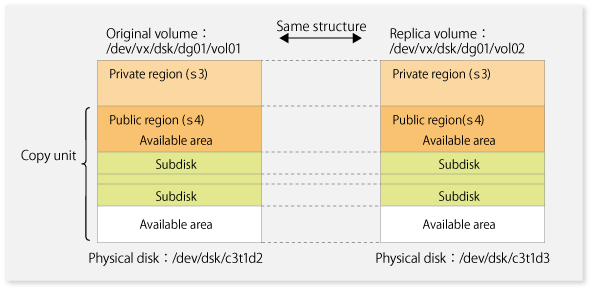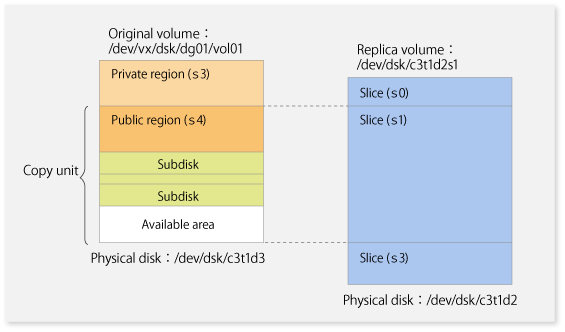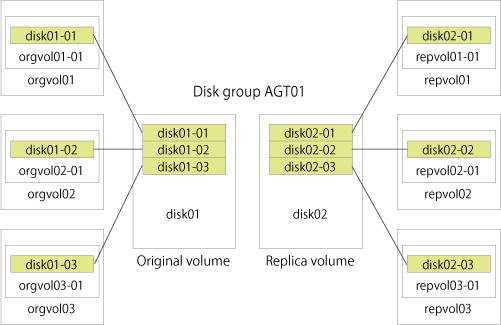Replication can only be performed when the VxVM volume configuration satisfies the conditions required for operation involving units of logical volumes.
Note
Before starting this operation, be sure to understand the basic operation of ordinary volumes.
For the supported VxVM volume structures, refer to "1.5 Managing a Device on AdvancedCopy Manager".
The following two types of volumes can be used as a replica volume of a VxVM logical volume:
Logical volume of VxVM
Slice
For this replica volume, however, use a VxVM logical volume in the same structure as that of the original volume where the replica volume is mounted or in use by another application.
The same volume structure means the following conditions are satisfied:
The size of the physical disk (LU) is the same.
The size of the private region is the same.
The size of the public region is the same.
Each sub-disk in the public region has a corresponding start offset and size.
The logical volume and sub-disks have a relationship.
Figure 6.51 Example of correspondence between transaction volume and backup volume (1)

Note
If the replica volume is the same size as the public region, the replica volume of a VxVM volume can be made into a slice. However, the replica volume generally cannot be mounted or used by other applications.
Figure 6.52 Example of correspondence between transaction volume and backup volume (2)

Similarly, a replica volume of a slice type can be made into a VxVM volume. However, the replica volume cannot be mounted or used by other applications.
If the target VxVM logical volume satisfies the condition of logical volumes: VM disk = N:1 (N>1), use one of the logical volume names included with each VM disk to register an original or replica volume, and set the replication volume information.
As an example, assume the original volume and replica volume in the following volume structures:
Figure 6.53 Volume structure example

VM disk disk01 (original volume) has logical volumes named orgvol01, orgvol02, and orgvol03, and VM disk disk02 (replica volume) has logical volumes named repvol01, repvol02, and repvol03.
VM disks disk01 and disk02 have the same slice size. The sub-disk structures of VM disks disk01 and disk02 are the same. The sub-disk structure can be checked by executing "vxprint -AGts".
In the above example, use the logical volume names of orgvol01 and repvol01 when setting the replication volume information.
# /opt/FJSVswsrp/bin/swsrpsetvol /dev/vx/dsk/AGT01/orgvol01 /dev/vx/dsk/AGT01/repvol01 swsrpsetvol completed # |
The logical volume name specified in the replication volume information setting command is used to specify the VM disk (slice) for replication processing.
This means that orgvol02 or orgvol03 instead of orgvol01 can be set in the above example. This is also true for repovol01.
However, if replication volume information for the combination of orgvol01 and repvol01 is already set, replication volume information using another combination of volumes (e.g., orgvol02 and repvol02) cannot be set.
If the target VxVM logical volume satisfies the condition of logical volumes: VM disk = N:1 (N>2), unmount/mount processing cannot be performed using the pre-processing or post-processing scripts.
For this type of structure, unmount the file system before executing replication, and mount the file system after replication creation.
If the target VxVM logical volume satisfies the condition of logical volumes: VM disk = 1:1, the logical volume is unmounted and mounted in the same way as in operation with normal slices and the following procedure is not required.
# umount /global/AGT01/repvol01 <-- unmount repvol01 # umount /global/AGT01/repvol02 <-- unmount repvol02 # umount /global/AGT01/repvol03 <-- unmount repvol03 # /opt/FJSVswsrp/bin/swsrpstartsync /dev/vx/dsk/AGT01/orgvol01 /dev/vx/dsk/AGT01/repvol01 FROM=/dev/vx/dsk/AGT01/orgvol01@svr1,TO=/dev/vx/dsk/AGT01/repvol01@svr1 swsrpstartsync completed : (check equivalency maintain status) # umount /global/AGT01/orgvol01 <-- unmount orgvol01 # umount /global/AGT01/orgvol02 <-- unmount orgvol02 # umount /global/AGT01/orgvol03 <-- unmount orgvol03 # /opt/FJSVswsrp/bin/swsrpmake /dev/vx/dsk/AGT01/orgvol01 /dev/vx/dsk/AGT01/repvol01 FROM=/dev/vx/dsk/AGT01/orgvol01@svr1,TO=/dev/vx/dsk/AGT01/repvol01@svr1 swsrpmake completed # mount -F ufs /dev/vx/dsk/AGT01/orgvol01 /global/AGT01/orgvol01 <-- mount orgvol01 # mount -F ufs /dev/vx/dsk/AGT01/orgvol02 /global/AGT01/orgvol02 <-- mount orgvol02 # mount -F ufs /dev/vx/dsk/AGT01/orgvol03 /global/AGT01/orgvol03 <-- mount orgvol03 # mount -F ufs /dev/vx/dsk/AGT01/repvol01 /global/AGT01/repvol01 <-- mount repvol01 # mount -F ufs /dev/vx/dsk/AGT01/repvol02 /global/AGT01/repvol02 <-- mount repvol02 # mount -F ufs /dev/vx/dsk/AGT01/repvol03 /global/AGT01/repvol03 <-- mount repvol03
# umount /global/AGT01/repvol01 <-- unmount repvol01 # umount /global/AGT01/repvol02 <-- unmount repvol02 # umount /global/AGT01/repvol03 <-- unmount repvol03 # umount /global/AGT01/orgvol01 <-- unmount orgvol01 # umount /global/AGT01/orgvol02 <-- unmount orgvol02 # umount /global/AGT01/orgvol03 <-- unmount orgvol03 # /opt/FJSVswsrp/bin/swsrpmake /dev/vx/dsk/AGT01/orgvol01 /dev/vx/dsk/AGT01/repvol01 FROM=/dev/vx/dsk/AGT01/orgvol01@svr1,TO=/dev/vx/dsk/AGT01/repvol01@svr1 swsrpmake completed # mount -F ufs /dev/vx/dsk/AGT01/orgvol01 /global/AGT01/orgvol01 <-- mount orgvol01 # mount -F ufs /dev/vx/dsk/AGT01/orgvol02 /global/AGT01/orgvol02 <-- mount orgvol02 # mount -F ufs /dev/vx/dsk/AGT01/orgvol03 /global/AGT01/orgvol03 <-- mount orgvol03 # mount -F ufs /dev/vx/dsk/AGT01/repvol01 /global/AGT01/repvol01 <-- mount repvol01 # mount -F ufs /dev/vx/dsk/AGT01/repvol02 /global/AGT01/repvol02 <-- mount repvol02 # mount -F ufs /dev/vx/dsk/AGT01/repvol03 /global/AGT01/repvol03 <-- mount repvol03
To prevent unmount/mount processing of the original volume, back up the volume by using the procedures described below.
# umount /global/AGT01/repvol01 <-- unmount repvol01 # umount /global/AGT01/repvol02 <-- unmount repvol02 # umount /global/AGT01/repvol03 <-- unmount repvol03 # /opt/FJSVswsrp/bin/swsrpstartsync /dev/vx/dsk/AGT01/orgvol01 /dev/vx/dsk/AGT01/repvol01 FROM=/dev/vx/dsk/AGT01/orgvol01@svr1,TO=/dev/vx/dsk/AGT01/repvol01@svr1 swsrpstartsync completed : (chekc equivalency maintain status) # lockfs -w /global/AGT01/orgvol01 <-- lock file system orgvol01 # lockfs -w /global/AGT01/orgvol02 <-- lock file system orgvol02 # lockfs -w /global/AGT01/orgvol03 <-- lock file system orgvol03 # /opt/FJSVswsrp/bin/swsrpmake /dev/vx/dsk/AGT01/orgvol01 /dev/vx/dsk/AGT01/repvol01 FROM=/dev/vx/dsk/AGT01/orgvol01@svr1,TO=/dev/vx/dsk/AGT01/repvol01@svr1 swsrpmake completed # lockfs -u /global/AGT01/orgvol01 <-- unlock file system orgvol01 # lockfs -u /global/AGT01/orgvol02 <-- unlock file system orgvol02 # lockfs -u /global/AGT01/orgvol03 <-- unlock file system orgvol03 # fsck -n -F ufs /dev/vx/dsk/AGT01/repvol01 <-- check file system backvol01 # fsck -n -F ufs /dev/vx/dsk/AGT01/repvol02 <-- check file system backvol02 # fsck -n -F ufs /dev/vx/dsk/AGT01/repvol03 <-- check file system backvol03 # mount -F ufs /dev/vx/dsk/AGT01/repvol01 /global/AGT01/repvol01 <-- mount repvol01 # mount -F ufs /dev/vx/dsk/AGT01/repvol02 /global/AGT01/repvol02 <-- mount repvol02 # mount -F ufs /dev/vx/dsk/AGT01/repvol03 /global/AGT01/repvol03 <-- mount repvol03
# umount /global/AGT01/repvol01 <-- unmount repvol01 # umount /global/AGT01/repvol02 <-- unmount repvol02 # umount /global/AGT01/repvol03 <-- unmount repvol03 # lockfs -w /global/AGT01/orgvol01 <-- lock file system orgvol01 # lockfs -w /global/AGT01/orgvol02 <-- lock file system orgvol02 # lockfs -w /global/AGT01/orgvol03 <-- lock file system orgvol03 # /opt/FJSVswsrp/bin/swsrpmake /dev/vx/dsk/AGT01/orgvol01 /dev/vx/dsk/AGT01/repvol01 FROM=/dev/vx/dsk/AGT01/orgvol01@svr1,TO=/dev/vx/dsk/AGT01/repvol01@svr1 swsrpmake completed # lockfs -u /global/AGT01/orgvol01 <-- unlock file system orgvol01 # lockfs -u /global/AGT01/orgvol02 <-- unlock file system orgvol02 # lockfs -u /global/AGT01/orgvol03 <-- unlock file system orgvol03 # fsck -n -F ufs /dev/vx/dsk/AGT01/repvol01 <-- check file system backvol01 # fsck -n -F ufs /dev/vx/dsk/AGT01/repvol02 <-- check file system backvol02 # fsck -n -F ufs /dev/vx/dsk/AGT01/repvol03 <-- check file system backvol03 # mount -F ufs /dev/vx/dsk/AGT01/repvol01 /global/AGT01/repvol01 <-- mount repvol01 # mount -F ufs /dev/vx/dsk/AGT01/repvol02 /global/AGT01/repvol02 <-- mount repvol02 # mount -F ufs /dev/vx/dsk/AGT01/repvol03 /global/AGT01/repvol03 <-- mount repvol03
Note
Even if "lockfs -w" is used to flush the file system cache and prevent subsequent update, file contents are not guaranteed for the file in Write Open (excluding the database space of Oracle used to support on-line backup).
If metadata renewal is in progress, consistency of data of the file system itself is cannot be guaranteed because "lockfs" is specified.
To handle this problem, perform "fsck" processing after replication to check the consistency of the data.
Even if the following message is output in "fsck" processing, there is no problem with the consistency of the file system. Execute "fsck -y" to restore.
FILE SYSTEM STATE IN SUPERBLOCK IS WRONG; FIX? |
To change the volume structure during the replication operation, follow the procedure below.
Delete the replication volume. For details on how to delete a replication volume, refer to "6.6.2 Deleting a source volume or replica volume".
Change the structure of the logical volume.
On the Web Console, execute the discovering all devices and reflecting information (Discover/Reload).
Re-configure the replication volume. For details on how to register a replication volume, refer to "6.4.5 Configuring the source volume and replica volume".
Resume the replication operation.